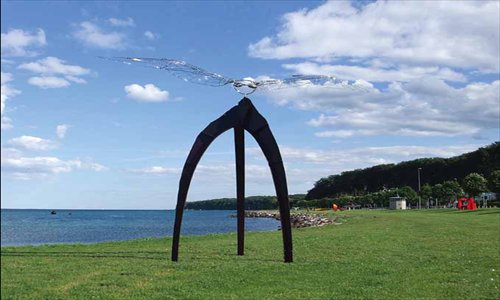
Under the theme of "Reactivation," the ninth Shanghai Biennale was unveiled at the beginning of this month, and it will continue until March 31, 2013.
This year the event is taking place in the Power Station of Art (PSA) beside the Huangpu River, as opposed to its usual home in the former Shanghai Art Museum (SAM) on Nanjing Road West. Transformed from a former power plant, PSA has been heralded as the first public museum of contemporary art on the Chinese mainland, and is twice larger than the former site of SAM.
Educators and inspirers
This year's theme has been sub-divided into four sections, namely Resource, Revisit, Reform and Republic.
The Resource section displays the works of artists who would like to become educators and inspirers by placing their art firmly in an everyday context. Revisit, meanwhile, focuses on the rejuvenation of deserted industrial areas, former communities and traditional handicraft arts, and also on rural development. The Reform section reveals work that has transformed everyday life into art, while the Republic section sheds light on how artists work with non-artists to create collaborative pieces of work.
This will also be the first year that the Shanghai Biennale is staging the concept of the "Inter-city Pavilion Project." Some 30 cities from around the world have arranged their exhibits in accordance with their own unique themes. Ten of them are located on the fifth floor of the new venue, while the other 20 are displayed in historical downtown buildings such as the Union Church, the MacMillan Building, the Yuanmingyuan Apartments, and the Lyceum Building.
Participating cities this year include Moscow (Russia), Antwerp (Belgium), Düsseldorf (Germany), Lima (Peru) and Diankou (Zhejiang Province, China). The Inter-city Pavilion Project will come to an end on December 31.
The Global Times spoke with the chief curator of the ninth Shanghai Biennale, Qiu Zhijie, to share his views of this year's event.
GT: Why did you decide on "Reactivation" as the theme of the ninth Shanghai Biennale?
QZJ: On one hand, it corresponds with the relocation of the Shanghai Biennale. The site used to be a power plant which was deserted for years, and the biennale is bringing fresh blood to this site.
On the other hand, I think it's high time that China and other countries began to rethink their methods of development. China has gone through rapid economic growth in the past few years, and it's high time we put more energy into developing culture and the arts, as well as rethinking our system of values and social justice. And we need more communication between the government and citizens in terms of developing art.
GT: Can you tell us about some of the exhibits you found particularly impressive?
QZJ: I like Salt City by Chen Wei very much. By showcasing more than 100 old items from her hometown - Zigong in Sichuan Province - the artist unveils the culture of this small place in a sensitive way.
Also Fall Again, Fall Better, an interactive installation by Hong Kong-based artists Jeffrey Shaw and Sinan Goo is another favorite. When visitors touch a specially-built handle, human images on a large screen fall to the ground. It's highly interactive, and reveals a sense of tragic sadness.
There are also works that will move visitors to tears, for example, The Last and First Time (video) and The Last Image (photography) by French artist Sophie Calle, which tell the stories of people who suddenly lost their sight.
While the Irrelative Group from China have organized Walking Project: Shoulder, which shows adult children bringing their blindfolded parents on trips back to places those same parents once brought them.
GT: There are so many biennale events in the world. What constitutes the unique characteristics of the Shanghai Biennale?
QZJ: The event is a symbol that China is able to hold such an event, and that we can make a serious contribution to the world of art. Now we are aiming to become one of the best biennales in the world. World-acclaimed biennales such as the Venice Biennale already have the national pavilions project in which countries showcase their distinctive arts.
But I think city pavilions avoid the strident nationalism that often goes with national pavilions. I think the Inter-city Pavilion Project allows more opportunities for different kinds of art to coexist, and it makes audiences feel attached to the arts as they exist in everyday life.
GT: What is the future of the Shanghai Biennale and how can it be improved?
QZJ: This year the Shanghai Biennale was able to receive some economic support from private enterprises, and I think this is a great development. In the future, the event can seek more support from society, rather than depending heavily on the government.
On the other hand, I think that it is necessary to enhance the professional training of staff working for the Shanghai Biennale and a good way of doing this is for them to attend other biennales.
Date: Until March 31, 2013, 9 am to 5pm (closed on Mondays)
Venue: Power Station of Art
上海当代艺术博物馆
Address: 200 Huayuangang Road
花园港路200号
Ticket: Free, but visitors should book the admission ticket on artshow.eastday.com (for individual visitors) and ticketing.exposhanghaigroup.com (for group visitors) two days in advance
Call 400-9219-021 for details

Copyright ©1999-2011 Chinanews.com. All rights reserved.
Reproduction in whole or in part without permission is prohibited.